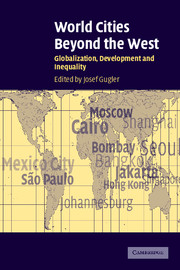Book contents
Introduction
Published online by Cambridge University Press: 12 October 2009
Summary
There is a first-world elitist bias to the globalization literature. Globalization is written from the metropolitan centre. Many of these writings are guilty of doing “bad geography” by only examining one or two representations of globalization.
(Short et al. 2000, p. 317)The notion of “world cities” has become prominent in the social sciences in recent years, and the literature has expanded at a rapid pace. Most of this literature, however, is focused on cities at the core of the world system. Much of it is devoted to the triumvirate of New York, London, and Tokyo, and where it moves beyond this “first tier” it usually explores North American and Western European cities. This volume seeks to broaden the inquiry beyond these cities, to adopt, as Robinson (2002) put it recently, a more cosmopolitan approach. We focus beyond the West in terms of political economy rather than geography.
A number of cities beyond the core play major regional and global roles. They make up a substantial proportion of “second-tier” world cities and must be part of any analysis. This is all the more important as these cities differ from their core counterparts in a number of ways. They are more subject to the economic, political, and cultural impact of core actors – governments, corporations, international organizations, universities, the media, even if there is considerable variation in their dependent status.
- Type
- Chapter
- Information
- World Cities beyond the WestGlobalization, Development and Inequality, pp. 1 - 24Publisher: Cambridge University PressPrint publication year: 2004
References
- 7
- Cited by

